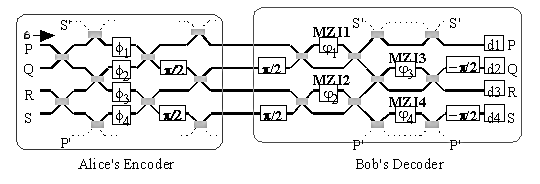Physical Science Laboratory
Ā@Modern cryptography offers many functions such as authentication and signature schemes, beyond usual uses for secret communication. Its security, however, relies on an unproven assumption that solving some mathematical problems requires huge computational time longer than the age of universe. By contrast, quantum cryptography aims at performing security information processing through quantum-state manipulation of carrier particles such as photon and guaranteeing the ultimate security on the basis of uncertainty principle of quantum mechanics. The most successful example is quantum key distribution that makes it possible for distant two parties to distribute a secure cipher key. It is, however, difficult to extend the basic idea of quantum cryptography to several magic protocols involving signature schemes, two-party secure computation, and so on. Moreover, there have been clarified fundamental difficulties in some of these efforts.
Ā@Our research motivations are to clarify (i) what kinds of quantum magic protocol are possible in principle, and (ii) what kinds of advantage we can expect for magic protocols by use of quantum mechanics. So far we have obtained two positive theoretical results on these points. One is the proposal of quantum communication protocol for cipher-text transmission that allows repeated use of the same cipher key [1]. Another proposal is a fault-tolerant simple quantum protocol for bit-commitment that is unbreakable by individual particle attacks [2]. The former makes it possible for legitimate users to avoid security degradation in the cipher key by monitoring the status of the key. The latter is a magic protocol for giving a receiver any evidence of sender's bit choice without revealing the bit value and is secure against any kinds of individual particle attack that is only a feasible attack until quantum computer networks are developed. In comparison with conventional quantum bit commitment protocols, our proposed scheme is mathematically far simpler, more efficient in terms of transmitted photon number, and better tolerant of bit-flip errors. Figure 1 shows a four-path single-photon interferometer that is employed as a quantum communication channel. Quantum state of each propagating photon can be manipulated by controlling the interference patterns [1].
Ā@* NTT Research Professor, Soken,The Graduate University for Advanced Studies.
[1] K. Shimizu and N. Imoto, Phys. Rev. A 60 (1999)157, Phys. Rev. A 62 (2000)054303.
[2] K. Shimizu and N. Imoto, Phys. Rev. A 65 (2002) 032324.

| Fig. 1. | Configuration of the four-path single-photon interferometer for the quantum channel. |